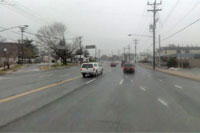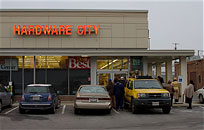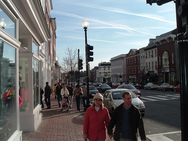Plan preserves Kensington’s assets while fixing its problems

10400 Conn. Ave., one of several unloved buildings in Kensington’s center. Photo by Jomo on Flickr.
For the past year, Kensington town councilmember Lydia Sullivan has been making fun of snobby suburbanites with Snoburbia, a T-shirt company and blog. But she’s not laughing at plans to allow redevelopment along a stretch of Connecticut Avenue that’s seen better days.
Sullivan and some of her neighbors have written up a website, called KensingtonDevelopment.info, to oppose the Kensington Sector Plan, which is currently working its way through the Montgomery County Planning Department for a second time.
Planners and town officials say it’ll bring much-needed amenities to the area while making it more attractive, but Sullivan’s concerned it’ll allow too many apartments, ruining Kensington’s “sense of place.”
“We are just battling for the soul of a place that already is different from the surrounding area,” she writes in one of many e-mails we exchanged over the past month. “Seriously, how many more generic, developerville town centers do we need in Montgomery County?”
The Sector Plan seeks to give Kensington something Sullivan says it already has: small-town character. They propose adding trees and wider sidewalks to Connecticut Avenue in the hopes of slowing cars down, by creating new parks and plazas were people can gather, and by using the new CR or Commercial-Residential zone, which will allow a mix of housing, shops and offices.
Nonetheless, the plan’s been very controversial, particularly its allowance of taller buildings up to 75 feet on Connecticut Avenue and 45 feet on adjacent blocks. KensingtonDevelopment is especially concerned with the number of apartments that could be built. “Montgomery County wants density and more moderate-income housing in downcounty areas like Kensington. (But is this good for people in and near Kensington?)” asks one page.
“For the first time in many decades, developers could build apartment buildings in sought-after Kensington,” says another. “The Plan could add between 501 — 1,410 multi-family units to a historic, single-family Town,” reads the homepage.
To Sullivan, who’s lived in Kensington for 18 years, the town is “Mayberry,” she says, where its “tone of small-town friendliness” has been unchanged for over a century. In an e-mail, she told me a story about running errands with her 11-year-old son one Saturday morning. “I was out maybe an hour — and saw 10 people I knew — because that is what it is like to live here,” she writes, adding that she doesn’t “expect me to understand.”

The intersection of Connecticut Avenue and University Boulevard in Kensington. Image from Google Street View.
Actually visiting Kensington, meanwhile, tells a different story. The century-old railroad town, laid out by Brainard Warner in the 1890’s and named for a fashionable district in London, has become one of the most sought-after suburbs in Greater Washington.
Yet in the 1950’s, two state highways, Connecticut Avenue and University Boulevard, were rammed through the town, bringing with them a mess of strip malls and office buildings that’s started to look quite shabby. Though both roads see thousands of people each day, they’re a distraction from the gorgeous, intact Victorian homes that sit just a block away.
You can see it in the pictures people take of Kensington: search for “kensington md” on Flickr and you’ll find pictures of the Mormon Temple, not of the town’s adorable Antique Row. The Planning Department held a a photo contest for Kensington residents to find what they liked about their community, and almost all the entries depict kids or flowers, not architecture or public spaces.
Mayor Pete Fosselman, who supports the Sector Plan, is eager to see the Connecticut Avenue corridor fixed up. “With our six gas stations and now a pawn shop, zero night life, lack of pedestrian connections, automobile dependent state, deficient open space, and no architectural oversight, Kensington is due for a makeover,” he wrote in an e-mail.
Fosselman has the support of other councilmembers, local businesses, and town residents, who say Sullivan’s part of a “vocal minority”.
Recently, Sullivan’s taken the fight to Snoburbia‘s blog, where she wrote about how places develop character:
Think about some of the places that are revered, that have been for many years. Think: Georgetown, Rhinebeck, Telluride, Santa Barbara, Athens, Burlington and many others like them. They don’t need “mixed use town centers” or manufactured “green space” and “pocket parks.”
We don’t know why, but we feel at home in these places. We walk on uneven sidewalks. We walk by imperfect windows filled with objects arranged (without a chart!) by local owners who know their customers. The downtowns were built slowly, over time, by locals.
That’s not the whole story, however. Places like Georgetown were built over time, but they’re also very dense, urban places. Georgetown has a street grid. It’s easy and pleasant to walk there. There are shops and offices, apartments and mansions, 19th-century factories and 21st-century embassies, all mixed together.
You can live there whether you’re a student or a Kennedy. This community formed because people live close together. But the urban form also allowed Georgetown to weather two hundred years of social and economic changes.
Kensington’s had over a hundred years to age, but it lacks the urban form, the density, or the diversity of a Georgetown. Sullivan doesn’t like “generic developervilles” like Downtown Silver Spring or Bethesda Row, but they’re a lot closer to Georgetown than Kensington is.
Beyond the chain stores and new buildings are all of the things that Georgetown teaches us about how to make a unique, pleasant place. They put lots of people and activity in a small area. They mix different classes and incomes as much as possible.
And they, too, have grown over time. Silver Spring has been an urban center for nearly a century, and tall buildings have been sprouting up since the 1960’s.
Allowing development in Kensington won’t automatically turn the town into a lifestyle center. But restricting development will keep out the people and activities that could make Kensington an even more unique and interesting place.
Even if everything that gets built in Kensington under the Sector Plan isn’t affordably priced (and not all of it will be), adding supply will still make it cheaper than it is now to live or work there. That lets people already living and working in the community invest there rather than being forced to go somewhere else.
Kensington today is a prohibitively expensive place to live. A search on real estate website HomesDatabase reveals three houses for sale in the town today, ranging in price from $489,000 to $959,000. KensingtonDevelopment points out that homes in the town sell for “an average of $150,000 to $200,000 more than equivalent houses” elsewhere, while a Post article on Snoburbia says Sullivan’s own house is assessed at $675,000.
She tells me the town already has “200+ moderately priced apartments” in a 1960’s-era high-rise just across the town line called Kensington House. But rents there range from $1,220 for a studio to $1,725 for three bedrooms, placing them out of reach for many working-class people.
On Snoburbia, Sullivan frequently explores the issue of privilege in her life. She’s mourned the departure of blue-collar families from her street and thoughtfully examined the separation between race and class in her kids’ high school.
In her latest blog post, she asks, “What happens to the small local pizza joint that has been here since 1967, where all the firefighters and police officers hang out? Will the Greek father and son owners be able to afford the rent in the shiny new building?”
These people are being pushed out of Kensington already by high housing prices due to a lack of supply there and throughout Montgomery County. Sullivan has an ideal of small-town life, but the version she wants is inherently exclusive.
Nonetheless, she’s willing to admit that Kensington could use some sprucing up. “I want to see a cleaned up commercial area as much as anyone, and would welcome some apartments and new people. That’s kind of exciting,” Sullivan writes. Yet she also sees it as a zero-sum game, asking on Snoburbia, “Will my town’s uniqueness, its sense of place, be lost?”
For Fosselman, the costs of not doing anything are much higher. “If we simply “spruce” up the town and go for status quo, Kensington will continue to deteriorate as other communities around us rejuvenate,” he writes.
If a great place is built over time, that means it’s always changing. If Lydia Sullivan really wants to preserve Kensington’s “sense of place,” she should let the town grow as it naturally would.



